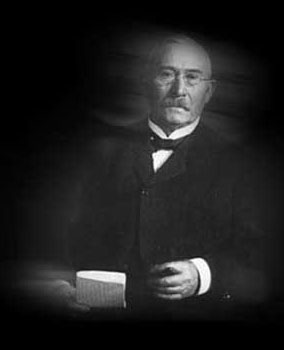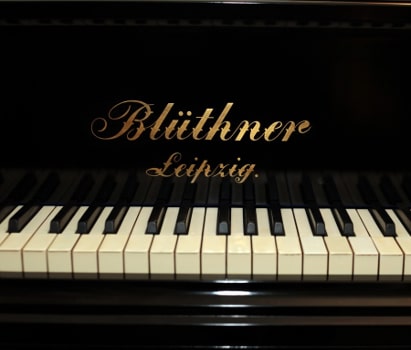
Blüthner – real German quality
The Blüthner family company was founded in 1853. Julius Blüthner received permission from the Leipzig authorities and began production of the first instruments. Three hard-working people joined Blüthner's cause. The young master, eager to succeed, worked almost without rest. His workers came to work at 6 o'clock in the morning, and he was already sitting there for 2 hours, working on samples or parts and often stayed up late. In the first year, 10 grand pianos and 2 upright pianos were made. The company gradually gained popularity and soon entered the international market.
Ever since those days, piano masters carefully pass their art from generation to generation. In more than a century, Blüthner company has created more than 150 thousand of instruments.
Today, Blüthner musical instruments are in high demand and the company has subsidiaries, service and business partners in many countries.
"Blüthner is perfection. The lyricism of the sound, which is responsible for the beauty of the human voice, can inspire any composer."
Peter Ilyich Tchaikovsky
"Blüthner instruments can really sing. This is probably the greatest compliment that can be paid to an instrument"
Wilhelm Furtwängler
Blüthner musical instrument manufacturing
 The quality of Blüthner's musical instruments has remained high since the company's establishment. It takes about eight years from the felling of the tree to the thorough final inspection and delivery of the instrument to the customer. Blüthner's signature is present on every instrument and is a sign of guarantee of the highest quality.
The quality of Blüthner's musical instruments has remained high since the company's establishment. It takes about eight years from the felling of the tree to the thorough final inspection and delivery of the instrument to the customer. Blüthner's signature is present on every instrument and is a sign of guarantee of the highest quality.
Wood is the main raw material in the production of Blüthner tools, and the most important thing is the correct selection of raw materials for each part. Even the distance between the annual rings in the trunk is important, which depends on the condition of the soil where the tree grows, as well as the content of minerals and electrolytes in the wood. Different varieties of trees are delivered to workshops from around the world. Each variety requires special endurance. Heavy wood, from which the base of the tool is made, can be dried for several years before it reaches the desired condition and becomes suitable for processing.
Pine and red beech are the main tree species used to make Blüthner instruments. Each breed is used for special purposes. Pine wood growing in the Mecklenburg area can withstand heavy loads and is used to make struts and other high-pressure parts. Red beech, which grows on German Alps foothills, is considered the best in the world. It is needed for the most important parts of the instrument, and each tree needs to be especially carefully selected before being cut down. Due to its high density, beech is best suited for joining in places of high pressure and laminated where it is necessary to keep the bolted parts. Red beech is perfect for making the bottom of the piano and the inner frame, where it should hold the sound bar, as well as a heavy iron frame. In the construction of the internal strut, the pine is laminated in red beech. This perfectly provides the strength needed to hold the entire structure and withstand the tension of the strings.
The steel frame is cast using a special technology. Due to the complex physical structure of the Blüthner frame, a high degree of precision and coordination is required in the foundry. Careful checks during the process of casting the frame guarantee its perfection.
To be sure that the frame can withstand the required pressure, created by the tension of the strings, various chemical tests are performed, as well as weighing the frame. The crystal structure with graphite provides internal absorption of harmful natural vibrations.
Special attention is focused on the sound bar. It is often difficult to find the right amount of quality spruce to meet the requirements. The tree must be large and straight, with annual rings located close to each other, only then will it be regarded as capable of resonance.
Trees growing in the Eastern Alps, Romania and the Ural Mountains are the best. Trees cut down in winter are put on sledges and taken out by horses from these hard-to-reach areas. Carefully transported and carefully inspected, the trees are sawn in a special way and dried. During drying, which can take several years, the inner cells of the wood undergo metamorphosis. The resin settles in the cell membranes and acquires a stable shape, which transmits the energy of the string, turning it into a sound wave.
The strings are made of steel that can withstand high stresses. Steel undergoes special stamping and is processed by a special patented technology. The high level of string diameter accuracy gives Blüthner instruments a clean and unique sound.
The copper wire is wound on a hexagonal wire while keeping stress exactly within required levels, which ensure that the copper strand will remain tight throughout the life cycle of the instrument.
The keys are made of spruce with dense annual rings. Each key is covered with red beech for strength in the screws and has an insert made of genuine calfskin in the slots. This guarantees stability for hundreds of years.
The surface of the keys is covered with a special plastic, which contributes to the greatest level sensitivity to the pianist’s touch. A special coating of natural ivory can be made to order. Coatings of black resin or dark red with black are also available on request.
The design of the piano has been improved by many generations of masters. Julius Blüthner contributed to this process by creating the Aliquot system. First patented in 1878, it was a new step towards the famous soft romantic sound of Blüthner instruments.
At this stage, the system is an additional fourth string in the treble part, attached to the bridge so that the hammers do not touch it. It resonates in response to the vibrations of the three basic strings, creating a rich and stunning dynamics of sound.
